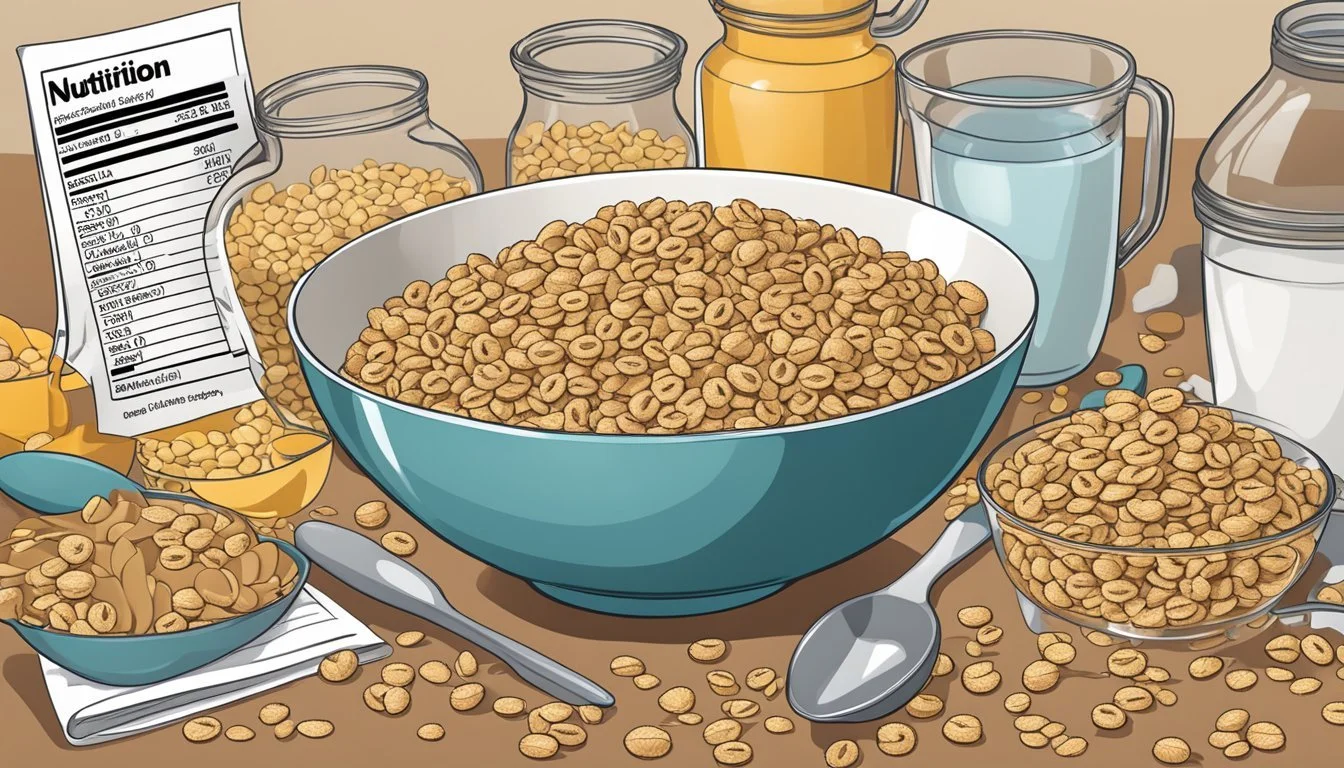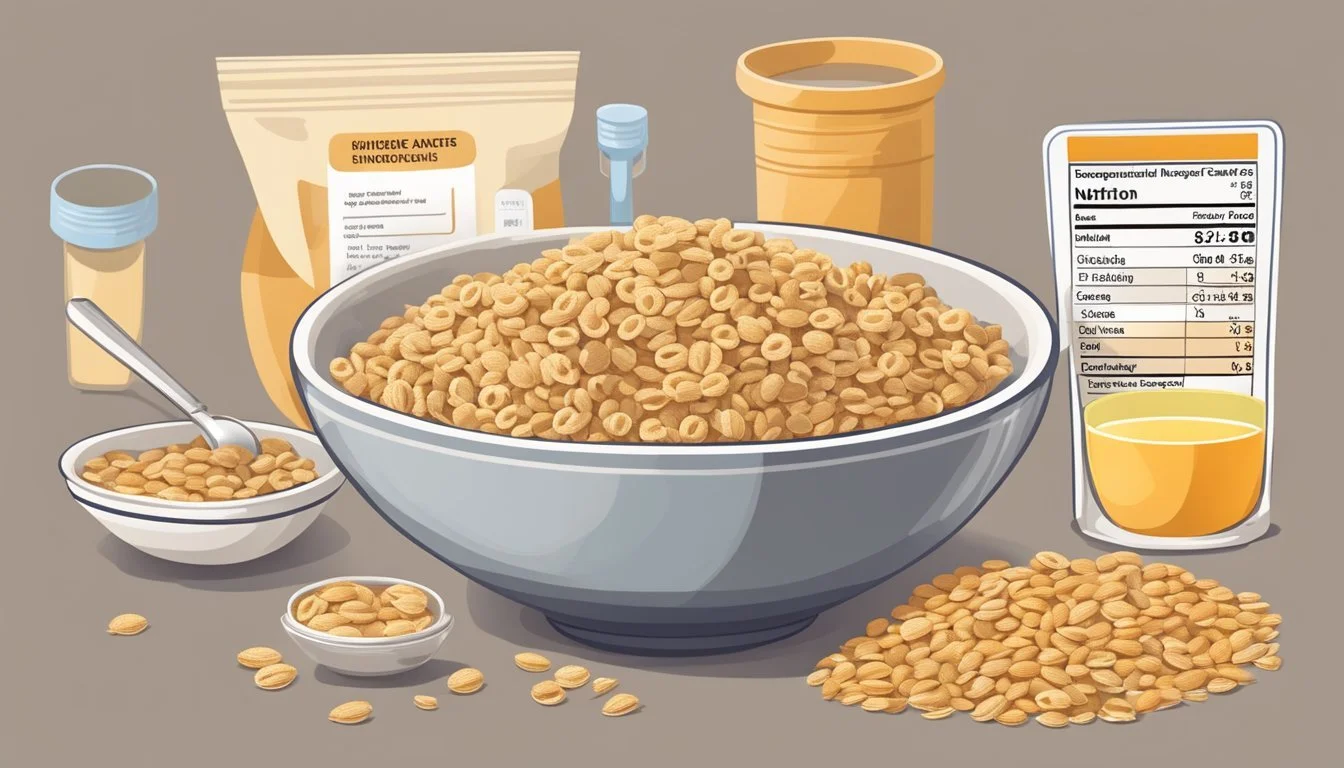How Much Cereal Per Day Is Too Much?
Understanding Healthy Portions
Cereal is a staple in many diets across the United States, with a vast array of options available in supermarkets. It's a quick, often nutritious choice for breakfast and can serve as a convenient snack. Although it's a popular food item, the sugar content in many cereals raises questions about its health impact. Some cereals, such as Kellogg's Froot Loops or Frosted Flakes, contain significant amounts of sugar, with around 12 grams per serving. The higher sugar varieties, for instance, Kellogg's Raisin Bran, contain as much as 17 grams per serving.
Consumption habits indicate that cereal is not only eaten at breakfast but also enjoyed as a snack. With statistics showing that an average American may consume up to 160 bowls of cereal each year, it's essential to consider the implications of these numbers on overall health. The act of eating cereal regularly could lead to an excessive intake of sugar, especially if higher-sugar cereals are chosen over those with lower sugar content. Additionally, portion control is a factor that needs to be considered as variability in bowl sizes has been shown to impact the amount of cereal consumed at each sitting.
Assessing Dietary Needs
When determining how much cereal one should consume, it's crucial to consider individual health requirements and understand the nutritional content of cereal varieties. Age, health status, and dietary goals directly influence optimal intake.
Impact of Age and Health on Cereal Intake
One's age and health are decisive factors in determining the appropriate amount of cereal to eat. For example, children and adolescents may have different energy and micronutrient needs compared to adults, necessitating more servings of nutrient-dense cereals. A registered dietitian can offer personalized guidance, ensuring that cereal intake contributes positively to one's overall diet and health goals. It's essential to select cereals that align with one's nutritional needs, whether to manage weight, control blood sugar levels, or ensure adequate intake of fiber and essential vitamins.
Understanding Nutrition Facts and Serving Size
It's fundamental to read and comprehend Nutrition Facts labels to make informed decisions about cereal consumption. A typical label will detail the:
Calories: Total energy per serving.
Carbohydrates: Including both simple sugars and dietary fiber.
Fats: Breakdown of saturated, trans, and other fats.
Protein: Amount contributing to daily intake.
The serving size indicated on the packaging is a critical benchmark for determining how much to eat in one sitting. Consuming multiple servings at once can lead to excessive intake of energy, sugar, and fats. Therefore, it's advised to measure out the cereal according to the listed serving size. One should also consider the type of milk or yogurt added, as this affects the overall nutritional profile and calorie count of the meal.
The Role of Cereal in a Balanced Breakfast
Breakfast cereals can be a convenient, nutritious option when incorporated into a balanced breakfast. They often provide essential vitamins and minerals, but selection is key for maximizing health benefits.
Nutritional Value of Common Breakfast Cereals
Nutritional content can vary widely among breakfast cereals. Whole-grain cereals typically offer more fiber and nutrients compared to those with refined grains. For example, oats are a popular choice providing both soluble and insoluble fiber, which can aid in digestion and heart health. Fiber is vital for maintaining a feeling of fullness, potentially aiding in weight management.
When seeking a healthy breakfast, one should look for cereals with:
Whole grains as the first ingredient (such as whole wheat, oats, or brown rice)
High fiber content – at least 3 to 5 grams per serving
Minimal added sugars
Inclusion of nuts and seeds for healthy fats and additional protein
Fortified with essential vitamins and minerals like iron and calcium
It's also beneficial to add fresh fruit or berries to cereal to further enhance the nutritional profile with additional natural fibers, vitamins, and a touch of sweetness without added sugars.
Optimizing Cereal Selection for Health
The healthiest cereal choices are those low in added sugars and high in fiber. Added sugars should be limited to reduce risk of chronic diseases like obesity and diabetes. High fiber content is important for digestive health and can help in feeling full for longer periods.
For a health-optimized cereal selection, consider:
Added sugars: choosing cereals with less than 5 grams of added sugars per serving
Sodium: opting for options with less than 200 mg of sodium per serving to maintain heart health
Fortification: selecting cereals fortified with nutrients can be beneficial, especially for those lacking in dietary diversity
Combining cereal with a source of protein such as yogurt or milk can balance the meal, and including a portion of fruit can provide antioxidants and additional fiber, rounding out a nutritious, balanced breakfast.
Understanding Cereal Ingredients
When selecting cereals, it's crucial for consumers to scrutinize ingredients for nutritional value, particularly concerning grain type and sugar content.
Whole Grains versus Refined Grains
Whole grains include all three parts of the grain kernel: the bran, germ, and endosperm. Common whole grains found in cereals are oats, barley, and corn. They provide essential nutrients and fiber, which can aid in digestion and overall health. The ideal cereal will list a whole grain as the first ingredient, indicating a higher whole grain content.
On the other hand, refined grains have been processed to remove the bran and germ, leaving only the endosperm. This process strips away much of the fiber and nutrients. A cereal's ingredients list that features refined grains like 'wheat flour' or 'milled corn' suggests a lower nutritional profile.
Identifying Added Sugars and Fats
The Environmental Working Group emphasizes the importance of checking cereals for added sugars. These are sugars that are not naturally occurring in the ingredients but are added during processing. It's advisable to choose cereals with less than 10 grams of sugar per cup of cereal. Consumers should look for terms such as 'high fructose corn syrup', 'honey', 'brown sugar', and other sweeteners listed among the top ingredients, which signal substantial sugar content.
Fats, while a necessary dietary component, can be unhealthy in large amounts or when sourced poorly. Cereals might contain added fats in the form of 'hydrogenated oils' or 'palm oil', which can impact cardiovascular health. Examining the list of ingredients and nutritional facts for the types and amounts of added fats can guide better choices.
Health Implications of Excessive Cereal Consumption
Excessive cereal consumption, particularly of high-sugar varieties, can have negative effects on health, including increased risk of obesity, type 2 diabetes, and heart disease. Portion size is crucial to prevent overeating and to maintain a balanced calorie intake.
Link Between High-Sugar Cereals and Health Risks
Consuming cereals high in sugar content can lead to a spike in calorie intake without necessarily improving satiety, potentially resulting in overeating. High-sugar diets are associated with various health issues:
Obesity: Excessive sugar intake can contribute to an imbalance in energy consumed versus energy expended.
Type 2 Diabetes: A diet high in sugar may increase the risk of developing type 2 diabetes due to the impact on insulin sensitivity.
Heart Disease: There is evidence that high sugar consumption may lead to cardiovascular complications.
High Blood Pressure: Diets with high sugar content are linked to elevated blood pressure levels.
Cancer: Some studies suggest that sugar-rich diets may be related to certain types of cancer.
Therefore, it is imperative to examine the sugar content in cereals and opt for those with reduced or no added sugars.
Managing Portion Sizes to Prevent Overeating
Proper portion control is key to preventing the negative health impacts of overeating cereal:
Calorie Intake: Awareness of portion size helps manage overall calorie intake, an essential aspect of weight regulation.
Satiety: Choosing whole-grain cereals that are higher in fiber can improve feelings of fullness and help in maintaining a healthy weight.
Obesity Prevention: Adequate portion sizes alongside a balanced diet can prevent the development of obesity and related health conditions.
To maintain a balanced diet, consumers should measure cereal portions according to the serving size recommendations on food labels and consider their total daily nutritional requirements.
Recommended Cereal Intake
When considering cereal intake, it is important to adhere to daily serving guidelines provided by reputable health organizations. These guidelines are designed to ensure a balanced diet and to help consumers avoid excessive sugar and sodium intake.
Daily Serving Guidelines from Health Organizations
According to the American Heart Association (AHA), the recommended limit for sodium intake is 1,500 mg per day. Consumers should aim for a cereal that contains no more than 200 mg of sodium per serving. While specific recommendations for cereal serving sizes aren't provided by the AHA, considering the overall dietary needs and limitations is crucial.
The Centers for Disease Control and Prevention (CDC) suggests focusing on portion sizes to maintain a healthy weight, which translates to being mindful of cereal servings. Although the CDC does not provide explicit cereal serving size guidelines, they emphasize the importance of moderation in all food groups.
Serving size: Typically, one serving of cereal is about 3/4 to 1 cup, but it can vary depending on the cereal brand and type.
Recommended serving: Look for cereals that are high in fiber and whole grains and low in sugar. A suitable portion size for most adults is 1 ounce (28 grams) or about 1 cup of ready-to-eat cereal.
It is advised for consumers to read labels carefully and measure out servings to avoid unintentional overeating, as cereal portion sizes can be misleading.
Enhancing Cereal Meals with Additional Nutrients
To optimize the nutritional value of a cereal meal, one can include proteins and healthy fats as well as a variety of vitamins and minerals. Such enhancements not only balance the meal but also contribute to overall health.
Incorporating Proteins and Healthy Fats
Proteins are essential for muscle repair and growth, and healthy fats are necessary for brain health and energy. One effective way to enhance a cereal meal with proteins and healthy fats is by choosing the right type of milk. Dairy milk naturally contains protein, whereas almond milk is often fortified to match these nutritional benefits. For added protein, consider sprinkling nuts such as almonds or walnuts on the cereal. Not only do they provide protein, but they also contribute healthy fats that are good for the heart.
Milk Choices for Protein:
Dairy milk: 8 grams of protein per cup
Almond milk: Often fortified with protein; check the label
Nuts for Protein and Healthy Fats (per ounce):
Almonds: 6 grams protein, 14 grams healthy fats
Walnuts: 4 grams protein, 18 grams healthy fats
Adding Vitamins and Minerals through Toppings
Vitamins and minerals are crucial for various bodily functions, including immune system support and bone health. Cereal can be a vessel for additional nutrients through the incorporation of fruit toppings. Berries, bananas, and raisins are not only flavorful but also rich in essential vitamins and minerals. Berries offer antioxidants and vitamin C, bananas provide a good source of potassium, and raisins are rich in iron and potassium.
Fruit Toppings for Vitamins and Minerals:
Berries: High in vitamin C and antioxidants
Bananas: High in potassium
Raisins: Source of iron and potassium
Impact of Cereal on Dietary Habits
Cereal consumption can influence dietary habits significantly, particularly concerning weight management and the intake of sugars and fats. These factors are crucial in determining the overall nutritional value and health implications of cereal as part of a daily diet.
Cereal's Role in Weight Management
Cereal can be a convenient breakfast choice that, when selected carefully, contributes to weight management. Whole grain cereals that are high in fiber and protein can promote satiety, reducing the likelihood of overeating. A high-fiber cereal may help maintain a feeling of fullness, which could aid in weight loss by curbing appetite and reducing the total caloric intake throughout the day.
Nutrient Benefit in Weight Management Fiber Increases satiety, potentially leading to reduced calorie consumption Protein Promotes muscle maintenance and satiety, aiding in weight management
Cereal as a Vehicle for Sugar and Fat Consumption
However, many cereals, especially those targeted at children, contain high amounts of sugars and sometimes fats, which can negate their nutritional value. High sugar content can result in a temporary sugar rush followed by a sharp drop in blood sugar levels, which may trigger further hunger and overeating. Regular consumption of such cereals can contribute to weight gain and less optimal health outcomes.
Type of Cereal Sugar Content Potential Impact High-sugar May exceed 10-12 grams per serving Can lead to increased appetite and weight gain Low-sugar Minimal Better for maintaining stable blood sugar levels
Selecting Healthier Cereal Options
When choosing cereals, focusing on sugar and fiber content is key for a healthier option. Cereals high in fiber and low in sugar can contribute to a balanced diet and support overall health.
Identifying Low-Sugar and High-Fiber Cereals
Low-Sugar Cereals: Cereals should ideally contain less than 5 grams of added sugar per serving. Added sugars contribute to calorie intake without providing nutritional benefits.
High-Fiber Cereals: Look for cereals offering at least 3 grams of fiber per serving. Fiber improves digestion and can help in managing weight by promoting a feeling of fullness.
Whole Grains: Whole-grain cereals are preferable as they contain the entire grain kernel, providing more nutrients and fiber than refined grains. Search for "whole grain" in the first few ingredients listed on the package.
Healthy Add-Ins: Consider adding fresh fruits or a handful of nuts to increase nutritional value. Accompanying your cereal with yogurt can boost protein intake as well.
Sugar Alternatives: If sweetness is desired, opting for natural sweeteners like fruits or a small amount of honey can be a healthier choice than cereals with high sugar content.
Type of Cereal Sugar (per serving) Fiber (per serving) Notes Bran flakes Low High Opt for ones without added sugars. Oatmeal Low High Old-fashioned oats are ideal. Muesli Low to Medium High Check label for added sugars. Shredded whole wheat Low High Avoid frosted options.
Granola can be a deceptive choice; while often marketed as healthy due to its inclusion of oats, it can be high in sugar and calories. Always read the label to ensure it fits within your dietary goals.
By seeking out cereals with higher fiber and lower sugar content, one can enjoy a wholesome breakfast that supports a healthy lifestyle.
Environmental and Regulatory Considerations
When considering the environmental impact and regulatory guidelines of cereal consumption, it is crucial to acknowledge both environmental obligations and the mandates set by regulatory bodies. Consumers are increasingly aware of the environmental footprint of their food choices, and regulations are pivotal in ensuring that product information is transparent and adheres to safety standards.
Regulations on Ingredients and Labeling
The Environmental Protection Agency (EPA) plays a crucial role in monitoring the environmental impact of food production. Cereal manufacturers must comply with EPA regulations to minimize their carbon footprint. A key issue in cereal production is the greenhouse gas emissions, which include the contributions from ingredients, manufacturing energy, and packaging. The Nutrition Facts Label and ingredients list are regulatory mechanisms overseen by the Food and Drug Administration (FDA). They require cereal manufacturers to provide detailed information about the contents and nutritional value of their products to ensure consumers can make informed dietary choices.
Nutrition Facts Label: Mandates disclosure of nutritional information such as serving size, calories, and nutrient values.
Ingredients List: Must clearly list all ingredients, with known allergens highlighted, and is instrumental in informing consumers about the contents of their cereal.
Registered dietitians often reference the Nutrition Facts Label to advise on appropriate cereal intake levels and can help individuals understand the dietary implications of overconsumption. Compliance with regulations and guidance from dietitians supports informed decisions about cereal consumption and its broader environmental and health impacts.










